Christmas Day is here, and Santa Claus has made his way down chimneys across the world. Here’s a look at the patents behind some of the toys and games he’s brought to children throughout the last century.
 Since America’s earliest days, many creative and innovative toys have come through the consumer marketplace. Many have become so iconic they are now household names and synonymous with a moment in time for America’s youth. Some of the most popular of these toys continue to show up year after year under Christmas trees and – you guessed it – were patented.
Since America’s earliest days, many creative and innovative toys have come through the consumer marketplace. Many have become so iconic they are now household names and synonymous with a moment in time for America’s youth. Some of the most popular of these toys continue to show up year after year under Christmas trees and – you guessed it – were patented.
Of course, it wouldn’t be a traditional Christmas at IPWatchdog unless we spent some time profiling some cool innovations that relate to the holiday season. So today, we return to one of our all time favorite articles. In 2013, we published The Top 10 Most Iconic (and Patented) Toys; in 2017 we published The Most Iconic (and Patented) Games; and last year we combined and updated the two lists. Despite our best efforts, when initially published, some truly iconic classic toys and games were left missing. With Christmas firmly in mind, it is time to once again revisit this list as we attempt to create the most comprehensive list possible.
Whether you celebrate the holiday or not, please join us as we look back at some of the most popular toys and games of all time, as well as the patents behind them. Our journey includes (in no particular order) iconic toys such as the Video Game Console, Barbie doll, Monopoly, Rubik’s Cube, Battleship, Super Soaker, Hoola Hoop, Slinky, Play-Doh, Easy Bake Oven, Game-Boy Frisbee, YoYo, Lego blocks, , Transformers, Tricycles, Bicycles, Scooters, Tonka trucks, Rocking Horse, Twister, Simon, Magic 8 Ball, Erector Set, Etch A Sketch, Bunch-o-Balloons and Mr. Potato Head. This year’s additions appear at the top of the list: Silly Putty, the Nerf Blaster, and Operation.
Merry Christmas!
Silly Putty
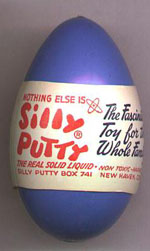 Silly Putty, similar to Play-Doh, is another example of unintentional product use. Initially, it was a solution to the rubber shortage during World War II. Credit for the invention was disputed. Earl Warrick claimed he should have been the inventor, but it was ultimately granted to James Wright. In 1950, Ruth Fallgatter took a gamble and turned a $147 loan for the purchase of a bulk of silly putty into a business that spanned both hemispheres of the world and beyond to the moon, where silly putty was used by the Apollo 8 astronauts. Today, Crayola products acquired the rights to Silly Putty, and sales continue to exceed 6 million eggs (in reference to the container in which silly putty is sold) annually.
Silly Putty, similar to Play-Doh, is another example of unintentional product use. Initially, it was a solution to the rubber shortage during World War II. Credit for the invention was disputed. Earl Warrick claimed he should have been the inventor, but it was ultimately granted to James Wright. In 1950, Ruth Fallgatter took a gamble and turned a $147 loan for the purchase of a bulk of silly putty into a business that spanned both hemispheres of the world and beyond to the moon, where silly putty was used by the Apollo 8 astronauts. Today, Crayola products acquired the rights to Silly Putty, and sales continue to exceed 6 million eggs (in reference to the container in which silly putty is sold) annually.
The USPTO issued U.S. Patent No. 2,541,851 to James Wright on February 13, 1951. No illustrations were included in the patent application, as these are not required for compositions of matter. The patent covers the unique combination of properties of the Putty including the “high degree of elasticity or “bounce” when under suddenly applied stress and the high degree of plasticity when the stress is applied slowly.” Additional interesting uses of the versatile putty range from lifting fingerprints to physical therapists using it for hand injury rehabilitation.
Nerf Blaster
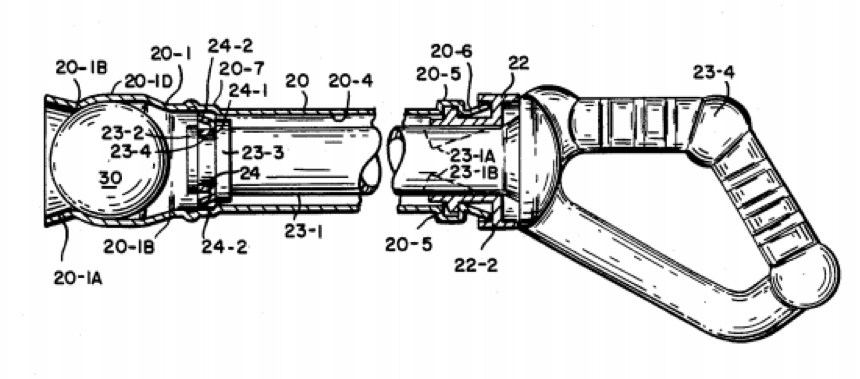 One of the most highly sought out and successful toys is the Nerf blaster, with an annual revenue of $410 million. “Nerf Blast a Ball” is the pioneer compressible ball launcher that set the stage for the resulting series. Randall Moormann was credited as the inventor and was issued U.S. Patent No. 4,892,081 on January 9, 1990. The patent covered a launching method for a single foam ball, which is compressed in a single barrel under pressure and then sprung out of the cavity accompanied by a loud popping sound. In 1991, Hasbro acquired the right to sell and produce Nerf products. The toy gained traction immediately thanks to prior success with the Nerf ball toy. A series of changes and modifications to the once single 1.5-inch ball launcher has now resulted in a foam dart projector with a capacity of 50 darts that can shoot up to 120 feet. The unit’s price starts at $3 and ranges up to $500 depending on the features of the unit.
One of the most highly sought out and successful toys is the Nerf blaster, with an annual revenue of $410 million. “Nerf Blast a Ball” is the pioneer compressible ball launcher that set the stage for the resulting series. Randall Moormann was credited as the inventor and was issued U.S. Patent No. 4,892,081 on January 9, 1990. The patent covered a launching method for a single foam ball, which is compressed in a single barrel under pressure and then sprung out of the cavity accompanied by a loud popping sound. In 1991, Hasbro acquired the right to sell and produce Nerf products. The toy gained traction immediately thanks to prior success with the Nerf ball toy. A series of changes and modifications to the once single 1.5-inch ball launcher has now resulted in a foam dart projector with a capacity of 50 darts that can shoot up to 120 feet. The unit’s price starts at $3 and ranges up to $500 depending on the features of the unit.
Operation game

In 2011, the USPTO issued U.S. Patent No. 7,988,561 on Operation, one of the most popular games arising out of the 1970s and still of great popularity today. What once was meant to be a college project turned into a renowned board game. The series of unfortunate events behind the inventor, John Spinello, started with a college project to design a game. Having experienced being shocked as a child when he stuck his finger in an outlet, he designed a game to guide a probe through a box’s grove without touching the sides. If the user touches the side, they would be mildly electrocuted. The game quickly caught momentum and Marvin Glass bought the rights for $500 and the promise of a job upon graduation – a promise not delivered. To add insult to injury, Spinello, ironically, needed an operation in 2014 that he could not afford, but, luckily, crowdfunders and eventually Hasbro stepped in to help. Operation is currently made by Hasbro and has a franchise worth $40 million.
Video Game Console
In April of 1973, the U.S. Patent and Trademark Office issued U.S. Patent No. 3728480, which is titled Television Gaming and Training Apparatus. Assigned to Sanders Associates, it lists Ralph Baer as the sole inventor. The patent claims an apparatus, used in conjunction with a standard television receiver, that generates dots upon the receiver’s screen which can be manipulated by a user. The patent further claimed the use of a joystick control to manipulate the dots on the screen. Although this may not look like the video game consoles that will be unwrapped this Christmas, this was the first of its kind and what created what has become a multi-billion in-home video game in industry.
In 1971, Magnavox licensed the technology and in the summer of 1972 released its Magnavox Odyssey Home Video Game System. To switch between games, a user inserted a cartridge into a slot on a console, much like the popular Atari, Nintendo and Sega consoles that would come years later. Unlike those cartridges, which contained internal circuitry required to play a game, these cartridges served as jumpers which completed the circuit connection required to select a specific game; all of the Odyssey’s games came preloaded on the console’s internal circuitry, which included 40 transistors and 40 diodes.
The Odyssey was a successful product with 130,000 were sold between the product’s September 1972 release and Christmas of that year. When the first model was discontinued in 1975, the Odyssey had sold a total of 330,000 consoles. For more information please see our Tribute to Ralph Baer.
Barbie
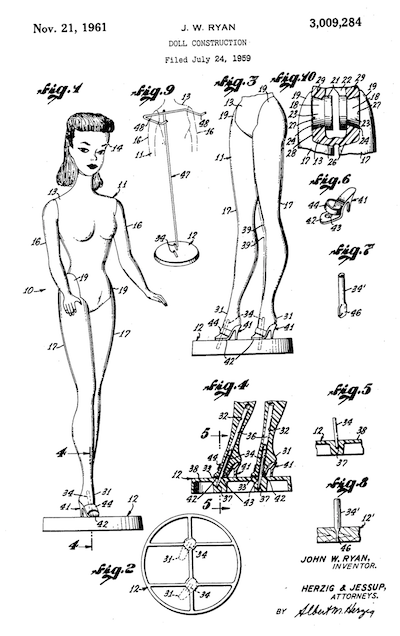 If you read the Barbie Wikipedia page it gives the credit to Mattel co-founder Ruth Handler, who on a trip to Europe came across a German toy doll called Bild Lilli. With the assistance of John Ryan, the page explains, Handler re-designed the doll and gave it a new name — Barbie. Ruth Handler is not mentioned on the first Barbie patent, U.S. Patent No. 3,009,284, which issued on November 21, 1961 (Figures from the patent shown right). Therefore, we will here say that the true inventor of the Barbie doll was John Ryan, a designer who worked for Mattel.
If you read the Barbie Wikipedia page it gives the credit to Mattel co-founder Ruth Handler, who on a trip to Europe came across a German toy doll called Bild Lilli. With the assistance of John Ryan, the page explains, Handler re-designed the doll and gave it a new name — Barbie. Ruth Handler is not mentioned on the first Barbie patent, U.S. Patent No. 3,009,284, which issued on November 21, 1961 (Figures from the patent shown right). Therefore, we will here say that the true inventor of the Barbie doll was John Ryan, a designer who worked for Mattel.
The ‘284 patent explains: “This invention provides a doll having a body and limbs in articulated relationship and means for supporting the doll in an upright or standing position for display or for storage.”
In 2016 Barbie sales leaped ahead 15%, but they are down a nearly identical amount in 2017. Notwithstanding, it is impossible to argue with the long term success of Barbie since she was first introduced in 1959. And even with sales declining there is no doubt that many will awake on Christmas morning to a Barbie under the tree.
Monopoly®
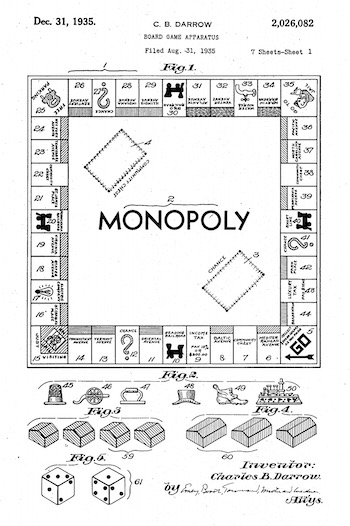 In 1935 the United States Patent and Trademark Office (USPTO) issued U.S. Patent No. 2,026,082 on Monopoly®, one of the most successful and beloved board games of all time.
In 1935 the United States Patent and Trademark Office (USPTO) issued U.S. Patent No. 2,026,082 on Monopoly®, one of the most successful and beloved board games of all time.
As the story goes, Charles Darrow, an unemployed salesman, was struggling to support his family during the Great Depression. It was during this time that he claimed to have fondly remembered summers in Atlantic City, New Jersey, and dreamed about being a real estate mogul. These diversions purportedly lead to him formulating what has become the most popular board game of all time – Monopoly®.
Darrow felt certain he had a hit on his hands so he contacted Parker Brothers, who initially turned him down, but only after explaining that his game violated some 52 fundamental rules of a board successful game. Undeterred, Darrow marketed the game himself. As fate would have it, a friend of Sally Barton, the daughter of Park Brothers’ founder, George Parker, bought the game. At the time Mrs. Barton’s husband was the President of Parker Brothers. One thing lead to another and eventually Parker Brothers became convinced that this game, with minor modifications, could be a huge success. As a result of his invention Darrow became the first millionaire game inventor, thanks to royalty payments.
The irony, however, is that Darrow may not have invented the game at all, but rather he may have taken a locally popular game and made only a few changes. By the time Parker Brothers realized that Darrow might not have been the true inventor the game was already a huge success. To protect the game and its investment the decision was made to buy up all patents and copyrights on any related game, thereby ensuring the monopoly on Monopoly®.
Rubik’s Cube
 One of the most popular games of the 1980s was the Rubik’s Cube, a puzzle game that proved enormously frustrating to many who attempted to unlock its solution.
One of the most popular games of the 1980s was the Rubik’s Cube, a puzzle game that proved enormously frustrating to many who attempted to unlock its solution.
Invented in 1974 by Hungarian inventor Ern? Rubik, the device was patented in the United States with the issuance of U.S. Patent No. 4,378,116 on March 29, 1983, with the title Spatial logical toy.
On a classic Rubik’s Cube, each of the six faces is covered by nine stickers, each of one of six colors: white, red, blue, orange, green, and yellow. See Wikipedia. A Rubik’s Cube craze captured worldwide attention in the 1980s, with tournaments and even the Guinness Book of World Records recognizing the fastest attempts to solve the puzzle.
Today the Rubik’s Cube has been a part of pop culture for decades, and has once again gained a new following with over 40,000 YouTube pages dedicated to the puzzle game.
Battleship
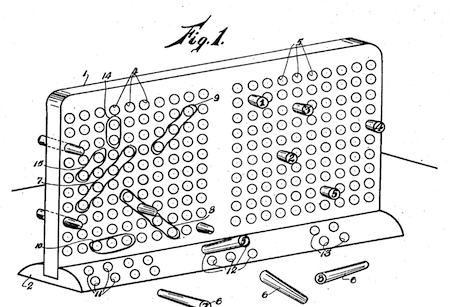 Another long time favorite game is Battleship. U.S. Patent No. 1,988,301 was issued on January 15, 1935 under the title Game board, the originally patented game does not bear a lot of resemblance to the one that many of us grew up playing.
Another long time favorite game is Battleship. U.S. Patent No. 1,988,301 was issued on January 15, 1935 under the title Game board, the originally patented game does not bear a lot of resemblance to the one that many of us grew up playing.
The patent explains that the invention relates to a perforated game board and pins insertable in the perforations. Although the patent explains that this perforated game board could be used for number of different games, the game we know as Battleship is described.
“The game herein illustrated as in progress might be called Battleships,” the patent reads. The game is described as requiring two players to sit facing each other. “One player, making use preferably of some erasable marking means, such as chalk, places an enclosure or line around a number of arbitrarily chosen series of perforations in groups of 4 (representing a battleship), in groups of 3 (a cruiser). The patent explains that play will go back and forth with each player calling out shots at the unseen target created by the other player. “Play continues thus and when one of the series of perforations within an enclosure has been filled with pins, that ‘ship’ is ‘sunk’.”
Super Soaker
The Super Soaker is one of the most successful toys of all time, selling in excess of $1 billion worth of product. Inventor Lonnie Johnson, a former United States Air Force engineer, was experimenting on a new type of refrigeration system when he conceived the method of using a pressurized water stream. He shortly thereafter conducted tests in his basement, built a prototype, and filed a patent application on his invention in October 1983. Ultimately he was issued U.S. Patent No. 4,591,071 on May 27, 1986. The invention in that patent was a toy squirt gun that shoots a continuous high velocity stream of water. It was the first of many patents on what would commercially become known as the Super Soaker®.
Success was not immediate, as is typically the case for independent inventors, but when success came it came big. Initially the toy was called the “Power Drencher” when it first went to market in 1990. After some tweaks and a name change, in 1991 $200 million worth of product flew off the shelves with units priced between $10 and $60 depending upon the features of the unit.
Game Boy
Nintendo’s Game Boy hand-held video gaming system was a pioneer gadget in the video game industry, defining an entire portable gaming market for more than 20 years. In it’s initial 1989 release in Japan, the 300,000 Game Boy units manufactured for the launch sold out within two weeks. During it’s American launch later that year, 40,000 units were purchased on the Game Boy’s first day on the market.
This patent, U.S. Patent No. 5,184,830, issued in February 1993 by the USPTO to the Nintendo Company Limited of Kyoto, Japan, protects the manufacture of the hand-held electronic gaming device known as the Game Boy. As the patent’s description states, the device was designed to be “sandwiched” by a user’s hands during game play. Images attached to the issued patent clearly show the iconic design of the grey brick with buttons, directional pad and dot-matrix LCD screen panel.
Toy Building Brick (aka Legos)
 Since its founding in 1932, the Danish corporation The Lego Group has been primarily involved in the creation of toys and playthings over the years. Despite some critical voices on the use of plastics instead of natural wood for children’s playthings, Lego began manufacturing plastic toys by the end of the 1940s. However, the interlocking plastic block the company released in 1958 and named the Lego exploded in popularity, eventually earning the honor of being chosen the “Toy of the Century” by both the British Toy Retailers Association as well as Fortune.
Since its founding in 1932, the Danish corporation The Lego Group has been primarily involved in the creation of toys and playthings over the years. Despite some critical voices on the use of plastics instead of natural wood for children’s playthings, Lego began manufacturing plastic toys by the end of the 1940s. However, the interlocking plastic block the company released in 1958 and named the Lego exploded in popularity, eventually earning the honor of being chosen the “Toy of the Century” by both the British Toy Retailers Association as well as Fortune.
Lego received U.S. Patent No. 3,005,282, on July 28, 1958, protecting the design and manufacture of their toy building brick in October 1961. As the patent states, the blocks are designed to connect through projections extending away from the block which can engage with protrusions on adjacent blocks. This design, also known as a stud-and-tube coupling system, allows children to create thousands of unique works with even just a few blocks.
Whirligig (aka YoYo)
 The yo-yo is a toy that predates any single company, and evidence of similar toys can be found dating back as far as 500 B.C. The American craze for the spinning toy can be traced back to the late 1920s, with the founding of the Yo-Yo Manufacturing Company by Pedro Flores, but the USPTO had been issuing patents to protect the manufacture and design of many yo-yos, whirligigs and “bandalores” for years.
The yo-yo is a toy that predates any single company, and evidence of similar toys can be found dating back as far as 500 B.C. The American craze for the spinning toy can be traced back to the late 1920s, with the founding of the Yo-Yo Manufacturing Company by Pedro Flores, but the USPTO had been issuing patents to protect the manufacture and design of many yo-yos, whirligigs and “bandalores” for years.
The term bandalore is used to describe the toy protected by U.S. Patent No. 59,745, issued in November 1866 to James L. Haven and Charles Hettrick, both of Cincinnati, OH. The invention is designed as two metal disks held together at the center by a clutch and rivet; the string is attached to holes found on either one or both of the metal disks. The patent discusses how this design enables the use of metal in the design, resulting in a higher degree of speed and momentum.
Flying Saucer

The popularity of the Frisbee also extends further back than the company that helped make it famous, although the toy’s name has remained very similar the entire time. Pie tins manufactured by the Frisbie Pie Company of New Haven, CT, became an interesting toy for nearby Yale University students who would throw the tins at unsuspecting students on campus. One of the precursors to the modern Frisbee would come in the late 1950s, when Walter Frederick Morrison began developing the toy from plastic.
U.S. Patent No. 3,359,678, issued in December 1967 to the Wham-O Manufacturing Company of San Gabriel, CA, protects the manufacture of a flying toy designed to reduce aerodynamic drag to be used in throwing games. The toy is designed to be held by a player with his thumb on the convex side of the disc and other fingers on the concave side. Force can be transferred to the disc when the user uncoils the arm holding the Frisbee and then snaps the wrist, causing it to fly.
Magic 8 Ball
 In 1946, American inventor Abe Bookman invented the design of a toy device known as the Magic 8 Ball. The design was conceived by Bookman’s brother-in-law, Albert Carter, who had the idea of creating and selling a fortune telling craft device. Interestingly, an 8-ball had been used to tell fortunes as a gag in the Three Stooges short film You Nazty Spy, which came out at least 5 years before Bookman and Carter developed their prototype.
In 1946, American inventor Abe Bookman invented the design of a toy device known as the Magic 8 Ball. The design was conceived by Bookman’s brother-in-law, Albert Carter, who had the idea of creating and selling a fortune telling craft device. Interestingly, an 8-ball had been used to tell fortunes as a gag in the Three Stooges short film You Nazty Spy, which came out at least 5 years before Bookman and Carter developed their prototype.
U.S. Patent No. 3,119,621, issued to Bookman in January 1964, is among the first patents issued to protect the design and manufacture of the fortune telling toy. This patent describes a toy containing liquid in which a buoyant indicator rises to a top window with a minimum of surface tension. This lower surface tension improves the visibility of the die and reduces its ability to stick against the internal walls of the 8-ball. Bookman went on to perfect the device in later years, as is evidenced by further patents he had received to protect Magic 8 Ball innovations.
Slinky
 The Slinky is one of the most popular toys of the past 100 years, but its use as a children’s plaything was entirely accidental. Richard James, a mechanical engineer, had created a type of sensitive spring that could keep fragile equipment from breaking on a ship or ocean vessel. One day, James knocked a spring from its shelf and watched it walk down onto the floor. When he demonstrated this effect for customers of Philadelphia’s Gimbels department store, he sold hundreds of toys in minutes.
The Slinky is one of the most popular toys of the past 100 years, but its use as a children’s plaything was entirely accidental. Richard James, a mechanical engineer, had created a type of sensitive spring that could keep fragile equipment from breaking on a ship or ocean vessel. One day, James knocked a spring from its shelf and watched it walk down onto the floor. When he demonstrated this effect for customers of Philadelphia’s Gimbels department store, he sold hundreds of toys in minutes.
The USPTO issued U.S. Patent No. 2,415,012 in January 1947 to Richard James, protecting a helical spring toy that can walk down an inclined plane or flight of steps without the application of external energy. The toy was designed to have a low natural frequency between 10 cycles and 100 cycles per minute. The patent also describes the importance of coiling the spring steel without substantial compression or lateral force tension to support the free movement of the spring.
Toy Oven
 In its two decades as a private company, before being bought by General Mills in 1967, Kenner Products succeeded because of a corporate culture that focused on developing its own ideas rather than improving other toys on the market. Unlike many of its competitors, Kenner tended to create toys that mimicked the appliances that children would see their parents using. This culture led directly to the creation of the Easy-Bake Oven, one of the most popular children’s toys of all time. In the Easy-Bake Oven’s first year of existence, 1963, 500,000 units were sold to American consumers.
In its two decades as a private company, before being bought by General Mills in 1967, Kenner Products succeeded because of a corporate culture that focused on developing its own ideas rather than improving other toys on the market. Unlike many of its competitors, Kenner tended to create toys that mimicked the appliances that children would see their parents using. This culture led directly to the creation of the Easy-Bake Oven, one of the most popular children’s toys of all time. In the Easy-Bake Oven’s first year of existence, 1963, 500,000 units were sold to American consumers.
U.S. Patent No. 3,368,063 was issued by the USPTO to Kenner Products in February 1968, protecting their innovatively designed toy oven. The original construction included a heating chamber and a cooling chamber situated side-by-side, as well as a passageway between those chambers. This passageway was fitted with tracks so that a baking pan could slide easily between the chambers. As the patent’s description states, the oven was designed to bake food that is “‘just like mother’s’ but on a much reduced scale.”
Etch-a-Sketch
In 1959, a French mechanic named Arthur Granjean exhibited a new toy that he had developed at the International Toy Fair in the German city of Nuremberg. He called his invention the L’Ecran Magique, or “The Magic Screen”. When no European investors lined up for his creation, he went to America where he was able to interest the Ohio Art Company in his design. After adding a few knobs to Granjean’s design, Ohio Art released the Etch A Sketch to much fanfare in 1960, a year in which this toy became a must-have as a children’s Christmas present.
The original USPTO patent for this device, U.S. Patent No. 3,055,113, issued to Granjean in September 1962, protects a device on which a user can trace any number of designs and then wipe them out immediately whenever they choose. The toy consists of a fluid-tight case with a translucent screen situated on one side. An internal tracing stylus is controlled by a user through the knobs, scraping a metallic material away from the screen so as to create a traced image.
Hula Hoop
 The Hula-Hoop is one of the great “flash in the pan” toy stories of the past 50 years; after sweeping quickly to worldwide popularity, the novelty of this invention wore off for most within months, although the hoop does have its share of fanatics to this day. Another Wham-O product, the Hula-Hoop sold about 25 million units worldwide within the first four months of production in 1958.
The Hula-Hoop is one of the great “flash in the pan” toy stories of the past 50 years; after sweeping quickly to worldwide popularity, the novelty of this invention wore off for most within months, although the hoop does have its share of fanatics to this day. Another Wham-O product, the Hula-Hoop sold about 25 million units worldwide within the first four months of production in 1958.
This patent, U.S. Patent No. 3,079,728, assigned to Wham-O co-founder Arthur K. Melin by the USTPO in March 1963, protects the manufacture of a hoop toy that a user swivels around his or her body. The weight and the diameter of the toy must be properly proportioned in order to maintain proper movement through coordinated action by a user. Along with its recreational potential, the health benefits of Hula-Hoop use because of constant motion and gyration are also noted in the patent document.
Play Doh
In another case of unintended product use, a wallpaper cleaner developed by Kutol Products of Cincinnati, OH, went on to become one of the most beloved ways for children to express themselves artistically. In the early 1950s, Joe McVicker, a Kutol employee, shipped some of the cleaning compound to local schools after he found that it served as a good substitute for modeling clay. In 1956, McVicker decided to call the new toy product Play-Doh, and since its creation children have played with nearly 700 million pounds of the substance.
The USPTO issued this patent to Joe and his uncle, Noah McVicker, in January of 1965. There is no illustration in this patent, which is unusual perhaps but not unheard of. The claims are directed to a “smooth and velvety composition of matter.” With compositions of matter (sometimes referred to as compounds) illustrations are not required.
This patent protects a slow-drying plastic modeling compound which is clean, non-toxic, non-sticky and non-staining. In its earliest days, Play-Doh was concocted of mixtures consisting mainly of tap water and grain flour mixed in equal portions, with about a fair amount of common salt added as well. On top of this basic formula, a very tiny amount of chemicals would be added, which could include borax, iron free aluminum sulphate or deodorized kerosene.
Rock’em Sock’em Robots
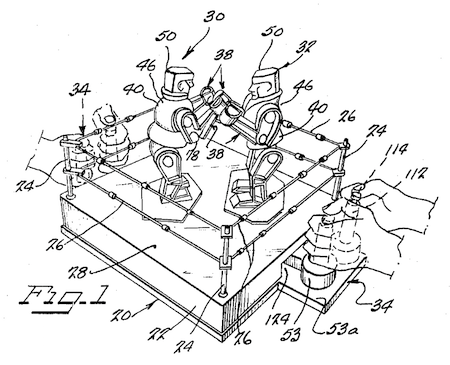 U.S. Patent No. 3,235,259, titled Toy boxers, was issued on February 15, 1966. The patent explains: “It is the primary object of this invention to provide a new and amusing toy in the form of a novel boxing game manually operated by opposing players.” Inventors Marvin Glass, Harry Disko and Burton Meyer, assigned the patent to Marvin Glass & Associates, and the first version of the Rock’em Sock’em Robots game was manufactured by Louis Marx and Company in 1964.
U.S. Patent No. 3,235,259, titled Toy boxers, was issued on February 15, 1966. The patent explains: “It is the primary object of this invention to provide a new and amusing toy in the form of a novel boxing game manually operated by opposing players.” Inventors Marvin Glass, Harry Disko and Burton Meyer, assigned the patent to Marvin Glass & Associates, and the first version of the Rock’em Sock’em Robots game was manufactured by Louis Marx and Company in 1964.
Rock’em Sock’em Robots was a game of battling robots, with each player trying to knock the others head off the block. The Red Rocker and the Blue Bomber would battle it out inside the ring.
Designed for two players, this boxing game required each player to a robot by operating the mechanism with his or her thumbs.
Transformer
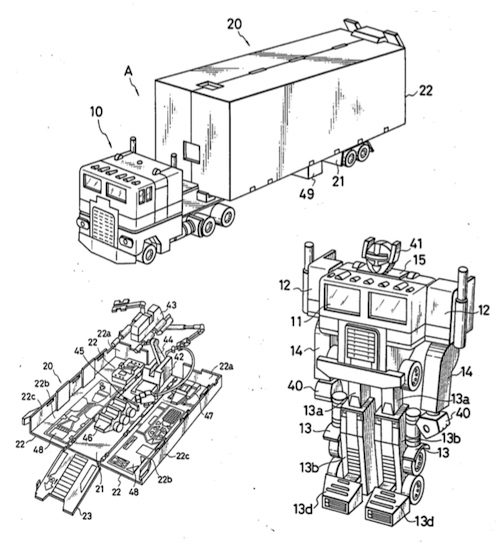 The inventor of what we know today as a Transformer is Hiroyuki Obara, who received U.S. Patent No. 4,516,948, titled Reconfigurable toy assembly on May 14, 1985. The patent explains that the toy assembly has foldable portions to allow the toy assembly to simulate a toy combination vehicle having a tractor unit and a trailer unit separately connected to each other. The toy when separated from the trailer unit is reversibly configurable into a robotic humanoid form.
The inventor of what we know today as a Transformer is Hiroyuki Obara, who received U.S. Patent No. 4,516,948, titled Reconfigurable toy assembly on May 14, 1985. The patent explains that the toy assembly has foldable portions to allow the toy assembly to simulate a toy combination vehicle having a tractor unit and a trailer unit separately connected to each other. The toy when separated from the trailer unit is reversibly configurable into a robotic humanoid form.
In addition to a line of toys, the Transformer toys have lead to a series of highly successful movies. The Transformer movie franchise began in 2007, and as of this writing, according to Wikipedia, the movie series Box Office has brought in $4.38 billion with a budget of $972 million. The top line Box Office will grow as the latest movie in the series — Bumblebee — has just been released for the holiday season.
Tricycle
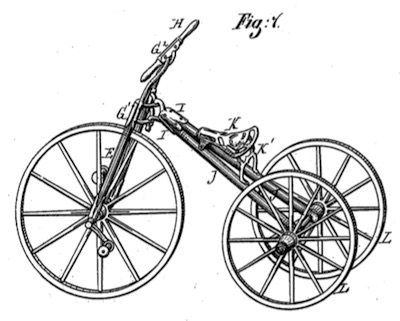 There is no doubt that Santa Claus will be leaving many a tricycle for good little girls and boys. These three wheeled bicycles are a virtual right of passage on the road to maturity.
There is no doubt that Santa Claus will be leaving many a tricycle for good little girls and boys. These three wheeled bicycles are a virtual right of passage on the road to maturity.
The earliest tricycle reference in an issued U.S. Patent is U.S. Patent No. 171,623, titled Improvement in Velocipedes, issued on December 28, 1875 (Fig. 1 of the patent shown to the right). Interestingly, when I searched this patent did not directly appear, but U.S. Patent No. RE9707 came up as the earliest mention of a tricycle. RE9707 is a reissue patent relating to the aforementioned ‘623 patent. Another interesting thing to note is the patent itself explains this is “an improvement in velocipedes of the tricycle variety”, which clearly suggests they were already known to exist.
While the tricycles that Santa leaves this year under the tree won’t look too much like the one depicted in the ‘623 patent, they will still no doubt bring great joy to all the good little girls and boys who receive them!
Incidentally, the term velocipede refers to a bicycle having two or more wheels that lacks springs. For more on bicycles please see The Evolution of the Bicycle: A Patent History.
Bicycles
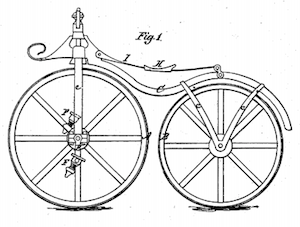 The earliest verifiable records of a modern bicycle comes from the German inventor Karl Drais. There are conflicting reports whether he applied for a patent for his bicycle, which became popular when it was introduced to France in 1818. There are reports that an American inventor, W.K. Clarkson, Jr., of New York, filed a patent for a similar invention. However, much of these records, if they existed, were destroyed in the U.S. Patent Office fire of 1836, the first major disaster to befall the patent office over the course of its history.
The earliest verifiable records of a modern bicycle comes from the German inventor Karl Drais. There are conflicting reports whether he applied for a patent for his bicycle, which became popular when it was introduced to France in 1818. There are reports that an American inventor, W.K. Clarkson, Jr., of New York, filed a patent for a similar invention. However, much of these records, if they existed, were destroyed in the U.S. Patent Office fire of 1836, the first major disaster to befall the patent office over the course of its history.
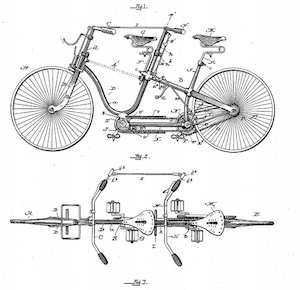 Perhaps the earliest U.S. patent issued to protect something that we can envision as a bicycle was U.S. Patent No. 59,915, which is simply titled Velocipede, and issued in 1866. The velocipede (shown left) is the term used at the time to describe what we would call a bicycle today. The patent protects an invention consisting of two wheels and a mechanism for driving the wheels.
Perhaps the earliest U.S. patent issued to protect something that we can envision as a bicycle was U.S. Patent No. 59,915, which is simply titled Velocipede, and issued in 1866. The velocipede (shown left) is the term used at the time to describe what we would call a bicycle today. The patent protects an invention consisting of two wheels and a mechanism for driving the wheels.
There was a good deal of innovation in the field of bicycles during the late 1800s. U.S. Patent No. 415,072, entitled Tandem Bicycle, was issued to inventors William Starley of Coventry, England, and Herbert S. Owen of Washington, DC, in November 1889. Patent diagrams (see right) show a tandem bicycle assembly similar to the tandem bikes still sometimes seen today.
Lionel Trains
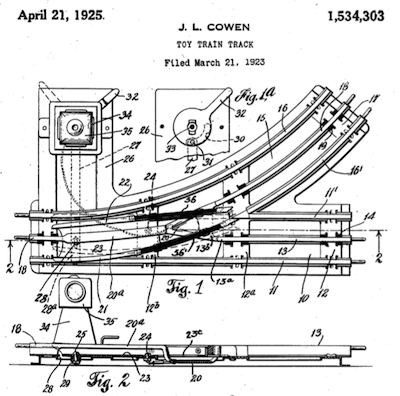 For many it just wouldn’t have been Christmas during our youth without a miniature train running under the Christmas tree. I have great memories of my uncle setting up his village under the tree every year, complete with train tracks and train.
For many it just wouldn’t have been Christmas during our youth without a miniature train running under the Christmas tree. I have great memories of my uncle setting up his village under the tree every year, complete with train tracks and train.
Inventor Joshua Lionel Cowen received U.S. Patent No. 1,534,303 for “new and useful Improvements in Toy Train Track”. Issued in April 1925, the invention related to toy railroad tracks with improved switching means, enabling the switching of the toy train from one track to another.
The success of Lionel toy trains was in no small part due to the fact that Cowen successfully convinced store owners to set up elaborate train tracks in their stores in order to increase interest, and demand. It worked. By the 1950s, Lionel Corporation had become the largest manufacturer in the world.
Rocking Horse
The first mention of a rocking horse in an issued U.S. patent was U.S. Patent No. 699,280, titled Traveling Rocking-Horse, which issued on May 6, 1902 (Fig. 5 of the patent shown to the left). The patent explains that the object of the invention is to provide a device for use by children and others “whereby the occupant or rider may with but a slight expenditure of labor propel himself from place to place.” Propelling one from place to place likely isn’t what we have in mind today when we think of a rocking horse, but this iconic device in one form or another finds itself in the hands of many a good little girl or boy on Christmas morning.
 Interestingly, when searching for tricycles I came upon U.S. Patent No. 1,338,545, which issued on April 27, 1920, and is titled Combined tricycle and rocking horse (Fig 3 of the patent shown to the right). The patent explains “the rocking horse provides a seat on the tricycle and in which the rocking motion of the seat thus provided is converted into a drive for the traction wheels of the tricycle.”
Interestingly, when searching for tricycles I came upon U.S. Patent No. 1,338,545, which issued on April 27, 1920, and is titled Combined tricycle and rocking horse (Fig 3 of the patent shown to the right). The patent explains “the rocking horse provides a seat on the tricycle and in which the rocking motion of the seat thus provided is converted into a drive for the traction wheels of the tricycle.”
Scooter
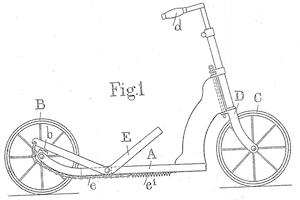 The earliest example of a patent on a scooter I could locate dates back to August 21, 1917 and the issuance of U.S. Patent No. 1,237,969, titled Skee-cycle or scooter (Fig. 1 of the patent shown to the left). The ‘969 patent explains that the invention relates to a wheeled vehicle for juveniles of the type having a narrow frame or board that is supported on two wheels, one at the front end of the frame and the other at the back end of the frame. It is further explained that the rider will stand upon the board with one foot while maintaining his or her balance and propelling the device forward by pushing off the ground using the other foot.
The earliest example of a patent on a scooter I could locate dates back to August 21, 1917 and the issuance of U.S. Patent No. 1,237,969, titled Skee-cycle or scooter (Fig. 1 of the patent shown to the left). The ‘969 patent explains that the invention relates to a wheeled vehicle for juveniles of the type having a narrow frame or board that is supported on two wheels, one at the front end of the frame and the other at the back end of the frame. It is further explained that the rider will stand upon the board with one foot while maintaining his or her balance and propelling the device forward by pushing off the ground using the other foot.
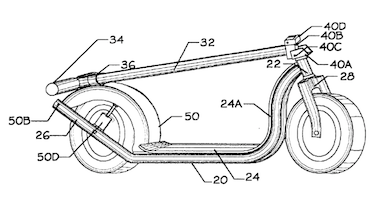 A scooter of more recent vintage, which is the type of scooter perhaps more likely to appear beneath a Christmas tree in 2017, is the sort of scooter described in U.S. Patent No. 5,927,733, titled Folding, portable, non motorized two wheel scooter, which issued on July 27, 1999 (Fig. 2 of the patent shown to the right). As the title implies, he ‘733 patent covers a folding, portable, lightweight scooter. There is a folding mechanism between the steering column assembly and the front yoke of the scooter, whereby the steering assembly can collapse and become secured in a generally parallel alignment with the main body.
A scooter of more recent vintage, which is the type of scooter perhaps more likely to appear beneath a Christmas tree in 2017, is the sort of scooter described in U.S. Patent No. 5,927,733, titled Folding, portable, non motorized two wheel scooter, which issued on July 27, 1999 (Fig. 2 of the patent shown to the right). As the title implies, he ‘733 patent covers a folding, portable, lightweight scooter. There is a folding mechanism between the steering column assembly and the front yoke of the scooter, whereby the steering assembly can collapse and become secured in a generally parallel alignment with the main body.
Scooters still remain a popular gift, and Razor scooter was the most popular Christmas gift in 2000. Indeed, as the scooter became increasingly popular Razor sued 16 competitors for patent infringement in 2000. The patent that was the subject of the Razor litigation was U.S. Patent No. 6,139,035, titled Brake device for a skate cart, issued to Taiwanese inventor Shui-Te Tsai on October 31, 2000, and later assigned to Razor USA.
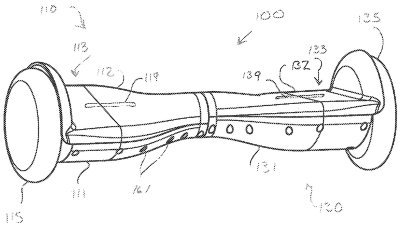 Of course, an even more modern version of a scooter is shown in U.S. Patent No. 8,738,278, entitled Two-Wheel, Self-Balancing Vehicle with Independently Movable Foot Placement Sections (Fig. 1 of the patent shown to the left) , and which covers a version of what has become known as The Hoverboard. The ‘278 patent claims a two-wheel, self-balancing vehicle that employs control logic that drives each wheel toward self-balancing in response to sensor data.
Of course, an even more modern version of a scooter is shown in U.S. Patent No. 8,738,278, entitled Two-Wheel, Self-Balancing Vehicle with Independently Movable Foot Placement Sections (Fig. 1 of the patent shown to the left) , and which covers a version of what has become known as The Hoverboard. The ‘278 patent claims a two-wheel, self-balancing vehicle that employs control logic that drives each wheel toward self-balancing in response to sensor data.
Twister
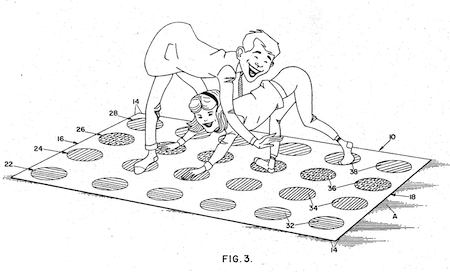 Twister has to make this list just because of the patent art on display in Fig. 3 (to the left) alone.
Twister has to make this list just because of the patent art on display in Fig. 3 (to the left) alone.
Invented by Charles Foley and Neil Rabens, and assigned to Milton Bradley Company, U.S. Patent No. 3,454,279, titled Apparatus for playing a game wherein the players constitute the game pieces, was patented on July 8, 1969. The patent explains: “The invention relates to a method of and equipment for playing a game of skill and chance for amusement and exercise purposes.”
The game is played with a playing surface the size of a large blanket, which has “a plurality of columns of loci, said loci being of such size and so spaces as to enable the players to place a hand or a foot on any designated locus, the columns of loci being different colors…” Don’t you just love the way patent attorneys write?
A “chance device” such as a spinner is included with the game. Someone not playing (i.e., a referee) will spin the wheel and call out a hand or foot with a corresponding color, which requires the players to twist and contort themselves in order to place the appropriate hand or foot on the color. The object of the game is to move into the appropriate position without falling. If a player falls or touches an elbow or knee to the surface the game is over and the other player declared the winner.
Simon
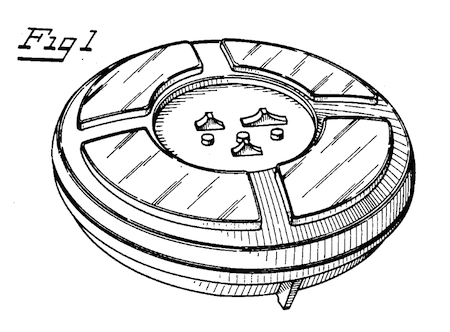 Ralph Baer, Hall of Fame inventor of the video console, was also the co-inventor of this extraordinarily popular, frustrating, and fun game. Baer, along with co-inventor Howard Morrison, invented this electronic game in the late 1970s, and launched in 1978.
Ralph Baer, Hall of Fame inventor of the video console, was also the co-inventor of this extraordinarily popular, frustrating, and fun game. Baer, along with co-inventor Howard Morrison, invented this electronic game in the late 1970s, and launched in 1978.
U.S. Design Patent No. D253,786 was issued on Christmas Day 1979 (Fig. 1 of the patent shown left). While that might seem odd to many, the United States Patent and Trademark Office issues patents every Tuesday, and December 25, 1979 happened to be a Tuesday. Obviously, all the work to allow the patent to be done was complete well in advance. In the U.S. a patent is not officially issued until it is published, which occurred on Christmas Day 1979.
For those not familiar with this iconic game, the device is made up of four colored buttons, which light in a series. The player must repeat the sequence correctly once the lights stop. Each time the player successfully completes the correct sequence the sequence becomes longer, and as the player continues the sequence gets faster and faster. This game can still be purchased today, but the new age Simon Optix seems more virtual reality headset than anything else. In an attempt to keep the game fresh for the next generation you wear the headset and wave your hand in front of the proper color in sequence. Other varieties of this classic game include the Simon Swipe and Simon Air.
Erector Set
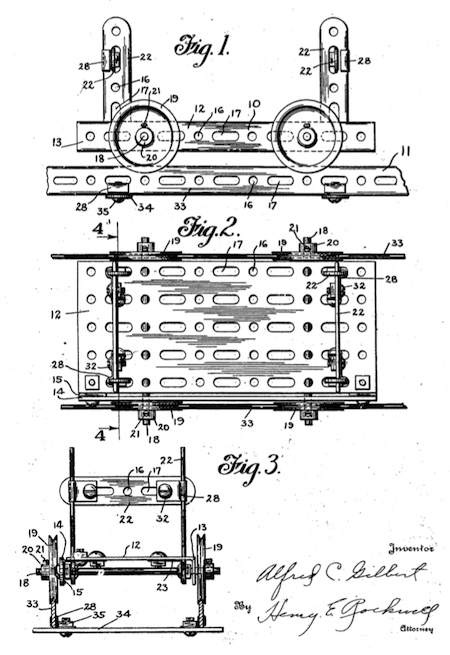 The Erector Set has been a favorite toy since the 1930s. Inventor Alfred Gilbert received U.S. Patent No. 1,724,470 on August 13, 1929. The title of the patent was simply Construction toy. The patent explains that the invention relates to “toys that may be fabricated or built up from a number of structural units or elements, which are standardized to such an extent that they may be assembled in various ways to build a great variety of toys.”
The Erector Set has been a favorite toy since the 1930s. Inventor Alfred Gilbert received U.S. Patent No. 1,724,470 on August 13, 1929. The title of the patent was simply Construction toy. The patent explains that the invention relates to “toys that may be fabricated or built up from a number of structural units or elements, which are standardized to such an extent that they may be assembled in various ways to build a great variety of toys.”
Designed for ages ten and older, the ingenious system of small parts combine in numerous ways to create an infinite number of models. No doubt many an engineer and inventor first found their love for building and tinkering while playing endless hours with an erector set.
Tonka Trucks
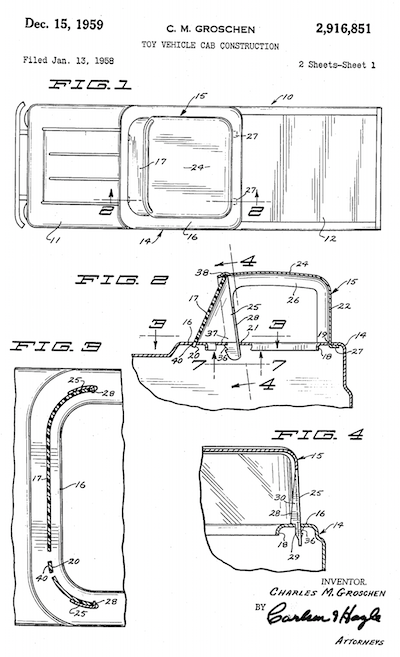 Tonka Toys Incorporated made its name creating and selling miniaturized steel trucks and work vehicles as toy for children.
Tonka Toys Incorporated made its name creating and selling miniaturized steel trucks and work vehicles as toy for children.
The earliest patent I could find relating to Tonka Trucks is U.S. Patent No. 2,916,851, which issued on December 15, 1959, and is titled Toy vehicle cab construction (Figures from the patent shown to the right). The patent explains: “This invention relates generally to toy vehicles, such as trucks, and particularly concerns the construction of the vehicle cab and the means of mounting the cab on the vehicle body.”
Another patent relating to Tonka Trucks is U.S. Patent No. 3,205,612, issued on September 14, 1965, and is titled Toy backhoe. The patent explains: “This invention relates to a new and improved construction for a schoop shovel or backhoe for mounting on toy vehicles, particularly the mechanism for operating the same.”
A quick Amazon.com search shows that there are hundreds of Tonka Trucks, whether it be the Classic Mighty Steel Dump Truck, or the Steel Tow Truck, or the Steel Cement Mixer, or even the Steel Bulldozer.
Bunch-o-Balloons
 Perhaps Bunch-o-Balloons is not “iconic” yet, but it is well on its way to being rightfully placed on this list as one of the most popular toys in the world. And the invention deals with water balloons, and you don’t get much more iconic than water balloons.
Perhaps Bunch-o-Balloons is not “iconic” yet, but it is well on its way to being rightfully placed on this list as one of the most popular toys in the world. And the invention deals with water balloons, and you don’t get much more iconic than water balloons.
Independent inventor Josh Malone got tired of how slow it was to tie water balloons one-by-one for his eight children. There was always a line of kids waiting and he just couldn’t go fast enough. So, he decided to come up with a way that you could fill multiple water balloons simultaneously, and he succeeded. The invention that is the subject of U.S. Patent No. 9,051,066, is simply titled System and method for filling containers with fluids. Issued in June 2015, this and his several other patents have already been thoroughly litigated after having been knocked off by Telebrands. Malone’s patents have held up in ever federal court, and at the Patent Office. It is easy to understand why. A device and method for filling 100 water balloons in 60 seconds is truly innovative, and why this is the most popular toy in the world during the summer months. Costco has them on pallets right at the front of the store, and they fly off the shelves.
Mr. Potato Head
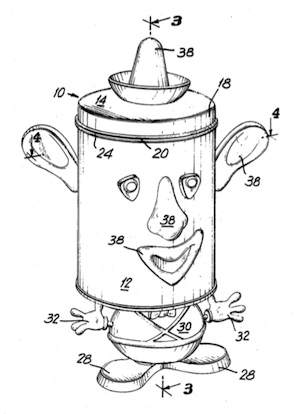 Mr. Potato Head is one of those toys that virtually every kid has had or has played with at one point in time. The toy was invented and developed by George Lerner in 1949, and first manufactured and distributed by Hasbro in 1952.
Mr. Potato Head is one of those toys that virtually every kid has had or has played with at one point in time. The toy was invented and developed by George Lerner in 1949, and first manufactured and distributed by Hasbro in 1952.
Some fun facts about Mr. Potato Head include: (1) On April 30, 1952, Mr. Potato Head became the first toy advertised on television. (2) The original Mr. Potato Head cost only $.98. (3) In the first year the Mr. Potato Head kit sold one million units, making it a huge success.
Although not relating to the original Mr. Potato Head, Lerner did receive U.S. Patent No. 3,660,926 on May 9, 1972. The invention related to a toy capable of being easily assembled by a child. The components were provided in a metallic container or can, and the decorative elements were magnetic and attached to the can. It doesn’t seem that this version caught on quite like the original, but with this clearly related patent to Lerner and true iconic status of Mr. Potato Head, an exception had to be made.
Image Source: Deposit Photos
Image ID: 60105799
Copyright: dorian2013

![[IPWatchdog Logo]](https://ipwatchdog.com/wp-content/themes/IPWatchdog%20-%202023/assets/images/temp/logo-small@2x.png)

![[[Advertisement]]](https://ipwatchdog.com/wp-content/uploads/2024/05/Patent-Portfolio-Management-2024-banner-super-early-bird-1500x500-1.jpg)
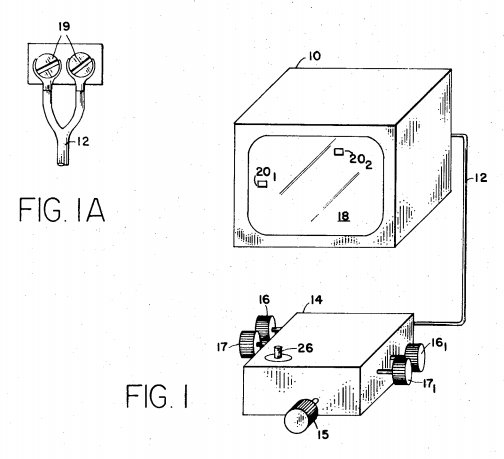




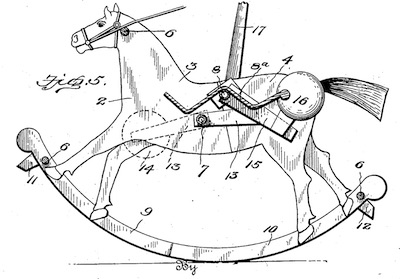
![[Advertisement]](https://ipwatchdog.com/wp-content/uploads/2024/05/Quartz-IP-May-9-2024-sidebar-700x500-1.jpg)
![[Advertisement]](https://ipwatchdog.com/wp-content/uploads/2024/04/Patent-Litigation-Masters-2024-sidebar-last-chance-700x500-1.jpg)

![[Advertisement]](https://ipwatchdog.com/wp-content/uploads/2021/12/WEBINAR-336-x-280-px.png)
![[Advertisement]](https://ipwatchdog.com/wp-content/uploads/2021/12/2021-Patent-Practice-on-Demand-recorded-Feb-2021-336-x-280.jpg)
![[Advertisement]](https://ipwatchdog.com/wp-content/uploads/2021/12/Ad-4-The-Invent-Patent-System™.png)






Join the Discussion
4 comments so far.
Anon
December 29, 2019 11:16 amAn excellent article to keep in mind when certain groups of people confuse “utility” with “technical arts.”
For the US Sovereign, our patent sense of “utility” is broader than any sense of “technical arts” (or ‘technical effect’) and include the utility of games and amusements.
Benny
December 27, 2019 08:35 amMeccano, patented in 1901 by Frank Hornby, predated Erector sets, which were basically identical in concept.
TFCFM
December 26, 2019 10:11 amThanks, Gene — Always a nice article, no matter how often posted!
Reading the description for the hula hoop patent:
“The weight and the diameter of the toy must be properly proportioned in order to maintain proper movement through coordinated action by a user,”
suggested a similarity to the functional patent claim language in the recent American Axel decision:
“…tuning at least one liner to attenuate at least two types of vibration transmitted through the shaft member…”
so I took a look at the original patent to assess whether I thought it would still likely be held valid today, in light of AA. I think it would. Even back in the early 1960’s, patent attorneys knew better than to claim naked function alone. Both independent claims in the patent include not only functional claim language like that above, but also claim language that recites what the weight and diameter actually are (at least as ranges).
Paul Cole
December 26, 2019 07:07 amI am not sure that they were patented, but Lego trains are one of the most useful and enduring toys our family had. Our two sons played with them from about the age of two until about the age of 10, and the layouts filled a large room. Our grandson has been an enthusiast since the age of one and a half and whenever he visits he makes straight for the boxes of Lego which can keep him occupied for hours.
Very best wishes to you and all readers for the rest of the holiday season and for a happy and prosperous 2020,